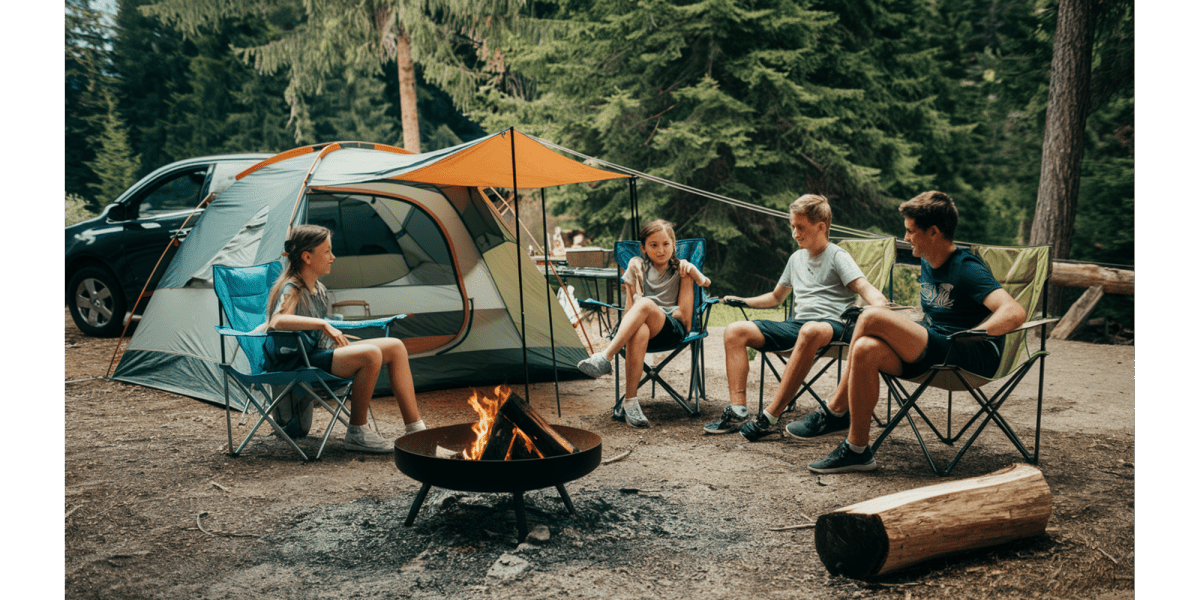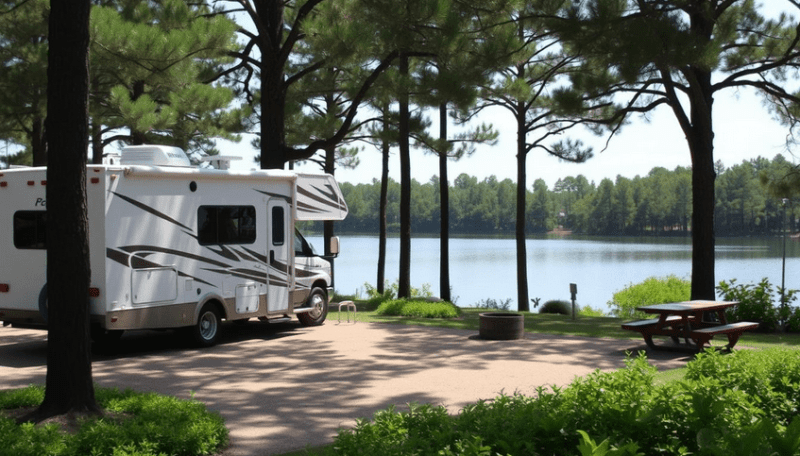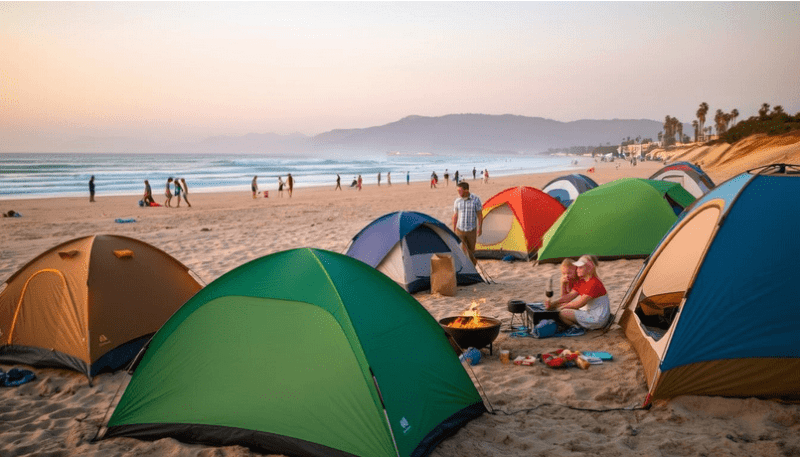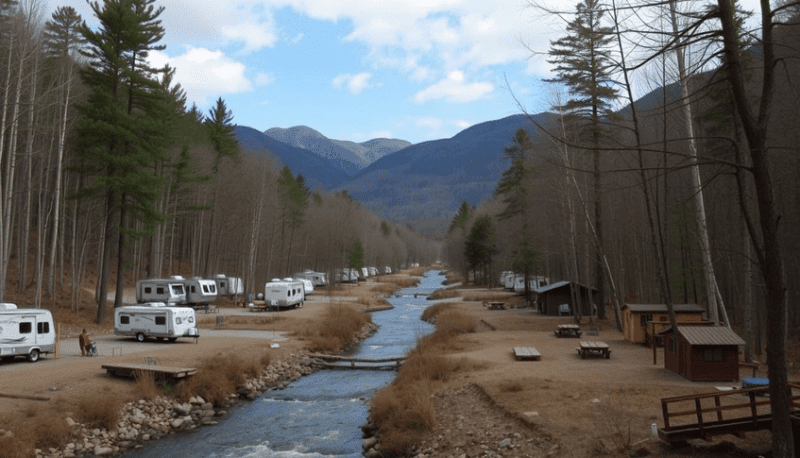Introduction:
Planning the perfect family camping trip can be an exciting adventure that brings us closer together. Choosing the right location, packing smartly, and planning activities for all ages are key to creating a memorable experience. With thoughtful preparation, we can ensure our time outdoors is filled with fun and connection.

As we embark on our camping adventure, we should consider everyone's interests. Selecting a destination that offers activities suitable for all family members is important. Whether hiking, swimming, or simply enjoying nature, these shared experiences can enhance our camping memories.
We can create an enjoyable atmosphere by following practical tips and focusing on our family's needs. As we dive into this guide, we'll explore essential aspects of planning, from choosing the right site to packing necessary supplies, ensuring our camping experience is nothing short of fantastic.
Choosing Your Camping Destination

Picking the right camping destination can make or break our family trip. We must consider several options catering to our interests, safety, and amenities. Let’s explore some excellent choices.
Exploring National Parks
National parks offer breathtaking landscapes and unique wildlife. These parks often have well-maintained trails and facilities, which are ideal for family outings. We can enjoy activities like hiking, birdwatching, and stargazing.
Key features to look for:
- Amenities: Clean restrooms, picnic areas, and campfire spots.
- Safety: Well-marked paths and ranger-led programs.
- Activities: Junior ranger programs and nature walks for kids.
Popular examples include Yellowstone and Yosemite. They are known for their stunning views and diverse ecosystems.
Discovering State Parks
State parks can be more accessible than national parks, but still provide plenty of adventure. They are often less crowded, which lets us enjoy nature without feeling rushed.
Things to consider include:
- Amenities: Many have swimming areas, playgrounds, and hiking trails.
- Events: Local parks might host family-friendly events, like guided nature hikes.
- Cost: Typically, state parks are budget-friendly with lower fees.
Researching state parks near our destination can reveal hidden gems that offer unique experiences.
Considering Campgrounds
Choosing the right campground is crucial. We should look for places that have family-friendly amenities, making our stay comfortable and enjoyable.
Important factors include:
- Facilities: Access to clean bathrooms, showers, and cooking areas.
- Location: Campsites near water or trails for easy access to activities.
- Safety: Campgrounds with well-lit paths and security features.
We can find campgrounds within national and state parks or independently. Checking reviews can help us narrow down our options to the best ones that fit our family's needs.
Essential Camping Gear
When planning our family camping trip, having the right gear makes all the difference. We want to be comfortable and prepared for different situations, whether it's sleeping under the stars or cooking meals together. Here are some key items we should consider.
Selecting a Tent
Choosing the right tent is crucial for a successful camping trip. We must consider size, ease of setup, and weather resistance.
-
Size: Our family should comfortably fit in a tent. Consider getting one that is rated for three or four people more than we need. This extra space allows for gear storage and some personal space.
-
Setup: Look for a tent that is easy for us to pitch. Pop-up tents or those with color-coded poles can save us time and hassle.
-
Weather Resistance: A good tent should handle rain and wind. We can check for features like a waterproof rainfly and sturdy stakes.
Choosing Sleeping Bags
Our sleeping bags are important for staying warm and cozy at night. When choosing one, pay attention to temperature ratings and size.
-
Temperature Ratings: We want bags rated for the conditions we expect during our trip. For example, a bag rated for 30-50°F is often sufficient for summer camping.
-
Size and Shape: Mummy bags can warm us, but rectangular bags offer more room. We can choose based on our comfort preferences.
-
Features: Checking for hoods, zippers, and materials will help us find bags that fit our needs. Lightweight options are great for backpacking, while heavier ones work for car camping.
Comfort with Camp Chairs
Having comfortable camp chairs can improve our overall camping experience. We should look for chairs that are portable yet sturdy.
-
Portability: Lightweight chairs that fold up easily are great for bringing along. We can also find chairs with carry bags for easier transport.
-
Support and Comfort: A chair with good back support and padding will make evenings around the campfire much more enjoyable. Some chairs even have cup holders for drinks.
-
Durability: Choosing materials that withstand tear and weather can ensure our chairs last through many trips.
Picking a Camp Stove
Cooking outdoors can be fun with the right camp stove. We need to choose one that fits our cooking style and group size.
-
Types: Propane stoves are popular for their efficiency and ease of use. We can also consider multi-burner stoves for cooking larger meals.
-
Portability and Weight: Lightweight options are best for backpacking, while larger models can be more suitable for car camping.
-
Features: Look for features like adjustable flame control and windshields. We may also need to bring fuel canisters, so check compatibility with our chosen stove.
Having the right camping gear sets us up for a memorable family adventure.
Packing for Your Trip
Packing for our family camping trip is crucial to ensure a smooth and enjoyable experience. We will focus on creating a clear packing list, essentials for food and cooking, as well as clothing and personal items.
Creating a Packing List
We should start with a packing list to keep our supplies organized. This list helps track what we have and what we still need.
Here is an example of what to include:
- Shelter: Tent, stakes, and footprint
- Sleeping Gear: Sleeping bags, pads, and pillows
- Cooking Supplies: Stove, cookware, and utensils
- Lighting: Headlamps, flashlights, and extra batteries
- Fun Items: Games and outdoor gear
We can categorize our list by type, making packing easier. Grouping items helps us avoid forgetting any camping essentials.
Food and Cooking Essentials
Food is an important part of our trip. We need to plan meals ahead of time to make cooking easy.
Key cooking essentials include:
- Stove or Portable Grill: For cooking meals
- Cookware: Pots, pans, and spatulas
- Utensils: Forks, knives, and spoons
- Cooler: To keep perishable foods fresh
- Food: Non-perishables like pasta, canned goods, and snacks
We should also pack extra items like condiments and seasonings for flavor. A menu plan helps reduce waste and ensures we have what we need for each meal.
Clothing and Personal Items
Clothing is important for comfort while camping. We need to pack for changing weather conditions.
Here's a basic list for clothing:
- Layered Clothing: T-shirts, long sleeves, and jackets
- Weather Gear: Rain jackets and hats
- Footwear: Sturdy shoes and sandals
- Sleepwear: Comfortable clothing for sleeping
Personal items matter too. We should bring toiletries like toothbrushes, sunscreen, and insect repellent. Don't forget a first aid kit for any minor injuries. Packing these items helps us stay comfortable and safe throughout our trip.
Family-Friendly Activities
Engaging in fun activities during our family camping trip can make the experience even more enjoyable. We can explore various options to keep everyone entertained and create lasting memories together.
Fishing with Family
Fishing is a great way to bond and enjoy nature. We can find a nearby lake or river that is family-friendly and has easy access. Before we head out, let's gather some basic fishing gear: rods, reels, bait, and tackle. If our kids are new to fishing, we can use simple hooks with worms or lures that attract fish.
It's important to check local regulations about fishing licenses and allowed species. We can bring a picnic lunch to enjoy while waiting for a bite. Remember to take plenty of photos to capture the fun moments and smiles on our kids' faces.
Kids' Camping and Hiking
Exploring the outdoor trails can be a fantastic way for our kids to learn about nature. We should look for kid-friendly hikes that are not too difficult. We can check local hiking maps and choose trails that are short and safe.
To make hiking more engaging, we can create a scavenger hunt. Our kids can search for interesting rocks, different leaves, or specific animals. Bringing along a nature journal can allow them to draw what they find. Sturdy shoes and plenty of water are also crucial for a comfortable hike.
Swimming and Water Fun
If our campground has a lake, river, or pool, swimming can be a fun activity. We should ensure that everyone has the right safety gear. Life jackets are essential for younger kids or weak swimmers.
Besides swimming, we can bring beach balls, inflatable toys, and paddles for added fun. Organizing water games like relay races or treasure hunts can keep the kids engaged. If we are swimming in natural water, let’s always keep an eye on our kids and respect safety signs.
Geocaching Adventures
Geocaching offers a high-tech treasure hunt experience for our family. We can use a GPS device or smartphone to find hidden caches in the area. It’s a fantastic way to introduce our kids to navigation and teamwork.
Before we start, we can register on a geocaching website and pick caches appropriate for our kids. In the caches, we might find small trinkets to trade. Always remember to leave a note about our adventure. Geocaching can turn our camping trip into an exciting adventure filled with exploration and discovery.
Setting Up Your Campsite
Setting up our campsite is essential for a successful family camping trip. We want to create a comfortable and safe environment for everyone. This includes knowing how to arrive, set up tents, and practice campfire safety.
Arriving at the Site
When we arrive at the campsite, we should first check in if required. This is also the time to pick our spot carefully. Look for flat ground that’s not too close to water. A shady area is great for hot days.
Before unpacking, we can walk around to identify potential hazards like branches or rocks. We should also take note of restrooms and water sources. Once we’re settled, it’s time to unload and start setting up.
Setting Up Tents
Setting up our tents correctly ensures everyone stays dry and comfortable. Choose a flat area free of debris for our tent. If we have a footprint or tarp, lay it down first.
Next, we can assemble the poles and attach them to the tent. Securely stake down the tent to avoid any surprises from wind.
We should also set up sleeping bags and pads inside. Organizing our gear will help keep the space tidy. Finally, storing food away from the tent is smart to avoid attracting animals.
Campfire Safety
A campfire can enhance our camping experience, but safety is crucial. First, check if campfires are allowed in our area. If they are, find a designated fire pit or create a safe, clear space with rocks to contain the fire.
Before starting the fire, gather dry wood and kindling. We should start with smaller sticks and gradually add larger logs. Never leave the fire unattended, especially around kids.
When we’re done, we must extinguish the fire completely with water. Stir the ashes to ensure everything is cold to the touch. Practicing these safety measures keeps our family safe and ensures everyone enjoys our camping experience.
Camping with Kids
Planning a camping trip with kids requires careful preparation and attention to their needs. We want our kids to have fun while being safe and comfortable. Here are the key points to keep in mind.
Preparing Your Kids
Before heading out, we should involve our kids in planning. This can create excitement and make them feel included. We can discuss the activities we will do, like hiking or fishing. They become more invested in the trip by letting them choose some of the fun things.
It's also wise to prepare them for camping life. Explain what to expect from the outdoors. Talk about sleeping in tents, cooking over a fire, and staying safe. Packing their gear, like sleeping bags and favorite toys, helps them feel more ready.
Kid-Friendly Campsite Setup
When we set up our campsite, we want to create a welcoming space for our kids. Choose a flat area away from hazards like cliffs or rivers. Position the tent close to our seating area for easy access.
Setting up a designated play area is helpful. We can use ropes to outline the safe zone. This helps kids understand where they can explore. Bringing lightweight, portable games can keep them entertained.
Make sure to have kid-friendly cooking options too. Simple meals and snacks, like hot dogs and s'mores, make cooking easy and enjoyable. A kid-friendly campsite makes our trip smoother and more fun for everyone.
Safety and First Aid
Safety is a top priority when camping with kids. We should pack a first aid kit that includes basic supplies like band-aids, antiseptic wipes, and allergy medication. Teaching kids about staying safe in the outdoors is essential.
We can explain the importance of staying close to the campsite. Setting up a meeting point in case anyone gets lost can prevent panic. It's also wise to teach kids about wildlife. Discuss which animals are safe to observe and which to avoid.
Having flashlights or glow sticks for the evening can help keep kids comfortable after dark. By focusing on safety, we ensure that our family camping experience is enjoyable and worry-free.
Responsible Camping Practices
When planning our family camping trip, we must focus on responsible practices to protect nature and ensure a great experience for everyone. This means minimizing our impact, keeping wildlife safe, and managing our waste effectively.
Leave No Trace
Leaving no trace means leaving the campsite just as we found it. This involves several key points:
- Plan: We must choose durable surfaces for our activities, such as established campsites or trails.
- Pack It In, Pack It Out: We should carry out all our trash, leftover food, and any other items we brought. This keeps the area clean and safe.
- Minimize Fire Impact: If we start a fire, we should use a designated fire ring and make sure it's completely out before leaving.
Following these guidelines can protect the environment while enjoying our camping experience.
Respecting Wildlife
Respecting wildlife is crucial for our safety and the safety of animals. Here are some ways we can do this:
- Observe from a Distance: We should never approach or feed wild animals. This keeps us safe and helps animals remain wild.
- Store Food Properly: Using bear-proof containers or hanging food can prevent animals from rummaging through our supplies, which keeps both us and the animals safe.
- Be Quiet. Lowering noise levels helps minimize stress for wildlife, allowing us to enjoy nature without disturbing the animals that live there.
Being respectful towards wildlife enriches our camping adventure and fosters appreciation for nature.
Managing Waste
Proper waste management is key to maintaining a clean campsite. Here’s how we can effectively manage waste during our trip:
- Use Trash Bags: We should bring durable trash bags for easy disposal of all waste.
- Dispose of Waste Properly: Always use designated restroom facilities or follow guidelines for disposing of human waste, like digging a hole away from water sources.
- Compost Food Scraps: If we can, composting food scraps helps reduce waste and can enrich the soil.
By managing our waste responsibly, we can keep our camping areas enjoyable for future visitors and protect the environment.
Conclusion
Planning a family camping trip is exciting and rewarding. It brings us closer as a family while enjoying nature. Here are some key points to remember:
- Equipment Matters: The right gear, like tents or a camper, is essential for a comfortable experience.
- Set Goals: Before we head out, let’s identify what we want to achieve during our trip. Are we seeking adventure, relaxation, or family bonding?
To make our camping experience even better, we can keep these tips in mind:
- Pack Smart: Bring plenty of snacks, extra blankets, and games to keep everyone entertained.
- Safety First: Always have a first aid kit and plan for emergencies.
By organizing our camping trip carefully, we can create lasting memories. Proper planning helps us enjoy our time outdoors and strengthens our family bonds. Every moment spent together in nature can lead to shared laughter and unforgettable stories. Let’s take these steps to ensure our camping adventure is the best it can be.
DISCLAIMER
This document is provided for general information purposes only and should not be relied upon as providing legal advice, technical, or specific operational guidance to the reader, whether as to the practices described in the document or the applicable legal requirements and regulations.Best Camping Deals. com expressly disclaims any responsibility for liability arising from or related to the use or misuse of any information in this document.



